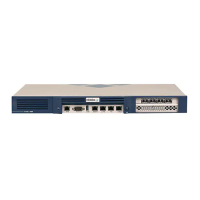Copyright ©2018, Infoblox, Inc.All right reserved.
Note: For ND-1405 and TR-1405 appliance models configured with 1GbE SFP or 10GbE SFP+ interfaces, the HA port is reserved for future use
and cannot be used for network applications. Order of ports from left to right is otherwise the same. (The PT-1405 does not support 10GbE
operation, but supports HA.)
Table 2 SFP/SFP+ Appliance Support Summary
Infoblox 1405 Series
Model
SFP/SFP+
Support
# of active SFP/ SFP+
ports
10 GbE
Support?
Accelerated 10 GbE
Support?
HA?
TE-1405, 1415, 1425
Y
1
4 Y N Y
ND-1405
Y
1
3 Y N N
TR-1405
Y
1
3 Y N N
PT-1405 SFP only 4 N
N
2
Y
– Optional 1 GbE or 10 GbE line card.
1
– Uses 1-GbE hardware acceleration for DNS security threats targeting DNS caching and authoritative applications
2
Interface Connector Pin Assignments
An Infoblox appliance has three types of ports on its front panel:
USB port (reserved for future use)
Male DB-9 console port
Four (4) RJ-45 10Base-T/100Base-T/1000Base-T auto-sensing gigabit Ethernet ports
Figure 4 describes DB-9 and RJ-45 connector pin assignments. The DB-9 pin assignments follow the EIA232 standard. To make a serial
connection from your management system to the console port, you can use an RJ-45 rollover cable and two female RJ-45-to-female DB-9
adapters, or a female DB-9-to-female DB-9 null modem cable. The RJ-45 pin assignments follow IEEE 802.3 specifications. All Infoblox Ethernet
ports are auto-sensing and automatically adjust to standard straight-through and cross-over Ethernet cables.
Figure 4 DB-9 Console Port and RJ-45 Port Pinouts

